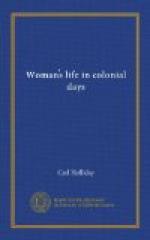V. Educational Frills
Toward the latter part of the eighteenth century that once-popular institution, the boarding school for girls, became firmly established, and many were the young “females” who suffered as did Oliver Wendell Holmes’ dear old aunt:
“They braced my aunt
against a board,
To make her straight
and tall;
They laced her up, they starved
her down,
To make her light,
and small;
They pinched her feet, they
singed her hair,
They screwed it
up with pins;—
Oh, never mortal suffered
more
In penance for
her sins.”
One of the best known of these seminaries was that conducted by Susanna Rowson, author of the once-famous novel Charlotte Temple. A letter from a colonial miss of fourteen years, Eliza Southgate, who attended this school, may be enlightening:
“Hon. Father:
“I am again placed at school under the tuition of an amiable lady, so mild, so good, no one can help loving her; she treats all her scholars with such tenderness as would win the affection of the most savage brute. I learn Embroiderey and Geography at present, and wish your permission to learn Musick.... I have described one of the blessings of creation in Mrs. Rowson, and now I will describe Mrs. Lyman as the reverse: she is the worst woman I ever knew of or that I ever saw, nobody knows what I suffered from the treatment of that woman."[72]
The Moravian seminaries of Bethlehem, Pennsylvania, and of North Carolina were highly popular training places for girls; for in these orderly institutions the students were sure to gain not only instruction in graceful social accomplishments and a thorough knowledge of housekeeping, but the rare habit of doing all things with regularity, neatness, decorum, and quietness. The writer of the above letter has also described one of these Pennsylvania schools with its prim teachers and commendable mingling of the practical and the artistic. “The first was merely a sewing school, little children and a pretty single spinster about 30, her white skirt, white short tight waistcoat, nice handkerchief pinned outside, a muslin apron and a close cap, of the most singular form you can imagine. I can’t describe it. The hair is all put out of sight, turned back, and no border to the cap, very unbecoming and very singular, tied under the chin with a pink ribbon—blue for the married, white for the widows. Here was a Piano forte and another sister teaching a little girl music. We went thro’ all the different school rooms, some misses of sixteen, their teachers were very agreeable and easy, and in every room was a Piano.”




